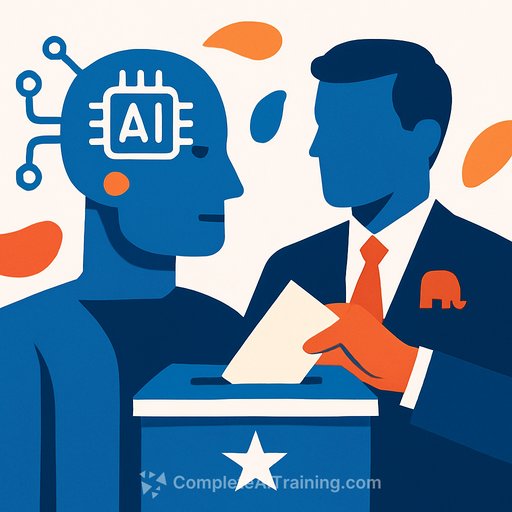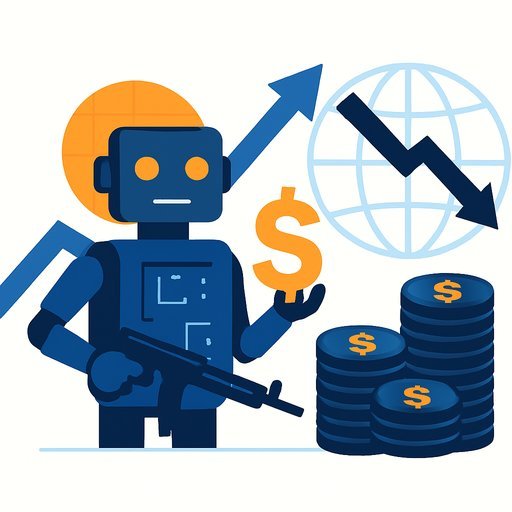AI Will Be a Political Variable in 2026: What Executives Should Watch
We are nearly a year out from the 2026 midterms. It's too early to call outcomes, but it's clear AI will sit at the center of the story again. AI is no longer just an influence threat. It is becoming a partisan instrument-and adoption is diverging across party lines.
The adoption gap is widening
Political first-movers are using AI for personalized outreach, persuasion, and campaign planning. If even a portion of AI's promise proves real, early adopters gain a repeatable edge. Right now, Republicans look better positioned for aggressive use-ranging from AI-native online messaging to efforts to steer the values embedded in major models. High-profile figures like Elon Musk are building models that reflect their own views, signaling a broader realignment inside Big Tech.
Democrats, operating out of executive power, have taken a more reactive stance. Prominent members of Congress have pressed for caution on federal AI adoption while acknowledging lawful use. Public opinion is not far apart: recent polling shows similar levels of concern about AI across both parties, even as rhetoric diverges. See the trends in this Pew Research Center collection on AI attitudes.
Policy posture: regulation vs. consumer risk
Expect Republicans to question new AI regulation and support industry flexibility. Expect Democrats to stress consumer protection and resisting concentration of corporate control. These are familiar positions that have defined technology debates for years. The balance can shift quickly with events, but the baseline is set.
Operational impact on campaigns
AI improves targeting, message testing, and content production at scale. That lowers the cost of persuasion and speeds iteration cycles. The side that systematizes prompt libraries, data pipelines, and field feedback loops will widen its reach without expanding headcount at the same pace.
Volatility: one news cycle can flip the script
A single headline can define the narrative. Sweden's Prime Minister Ulf Kristersson faced intense backlash after acknowledging personal use of AI tools, even though other AI-related controversies had been more consequential. Expect similar flashpoints in the U.S., where the use of AI may draw more heat than the policies that govern it.
Younger voters matter, but attitudes are mixed
Younger Americans interact with AI more, hear more about it, and feel relatively comfortable with their level of control. That does not automatically translate into support for any party. Either side could lean in or pull back on AI as a signal to win attention from younger voters. The net effect remains an open question.
Strategic implications for business leaders
Politics will influence AI roadmaps, ecosystem alliances, and enforcement priorities. Your AI plans will be judged through a partisan lens, even if your intent is neutral. Prepare for uneven policy signals, sporadic outrage cycles, and platform rules that can change without warning.
What to do now
- Scenario plan: model three futures-light-touch rules, targeted guardrails, and aggressive enforcement-and stress-test your AI portfolio against each.
- Content integrity: implement media provenance (watermarking, C2PA), detection workflows, and escalation playbooks for deepfake incidents affecting your brand or executives.
- Data discipline: tighten first-party data governance, consent, and model audit trails. Assume discovery requests and public scrutiny during election season.
- Channel strategy: map platform policies by risk tier. Build redundancy so a rule change or API limit does not stall your operations.
- Human-in-the-loop: pair AI outputs with expert review for anything public-facing, compliance-sensitive, or brand-defining.
- Measurement: attribute impact at the tactic level (creative variants, prompts, model versions) to keep spending tied to outcomes, not hype.
- Training: upskill leaders and operators on prompt quality, evaluation, and responsible use standards before campaign season accelerates.
Participatory tech is underused
AI-assisted public input platforms exist and work at scale, yet few political actors use them well. Tools like Decidim and Pol.is-style sensemaking can collect, cluster, and surface constituent priorities. Used correctly, they show responsiveness instead of broadcasting more noise. The same methods apply to enterprises running large stakeholder consultations.
Risk watchlist for 2025-2026
- Model value drift: mainstream models adjust safety settings and training data; outputs can shift without notice.
- Content policy swings: platforms update political content rules mid-cycle; paid media approval standards tighten.
- Synthetic media fatigue: audiences tune out generic AI content; distinct voice and proof of authenticity win.
- Regulatory whiplash: state-level rules tighten faster than federal action, fragmenting compliance.
Bottom line
AI is not an uncontrollable storm. It is closer to fire-useful, risky, and highly symbolic. In 2026, the side that systematizes its use will likely gain an operational edge, and the business community will feel the spillover. Plan for signal noise, keep your governance tight, and invest in teams that can move fast with guardrails.
If your leadership team needs structured upskilling on practical AI use, governance, and evaluation, explore executive-focused programs at Complete AI Training.
Your membership also unlocks:






